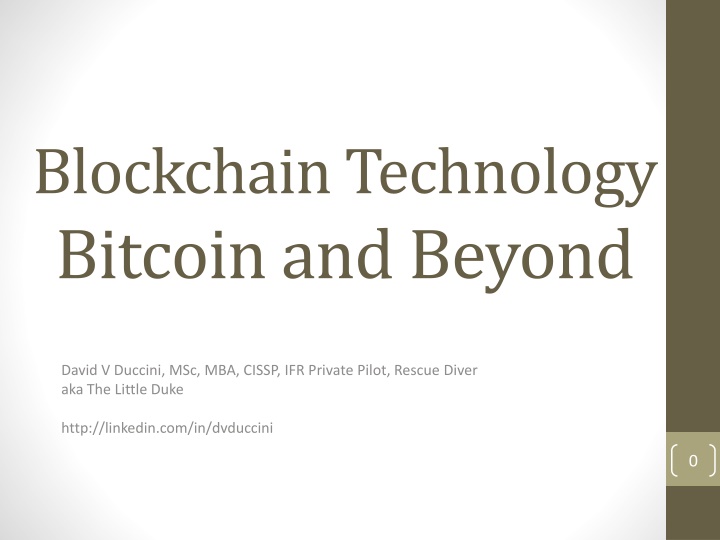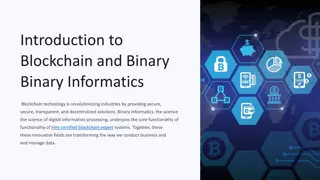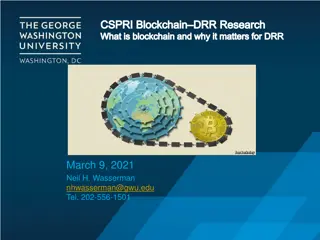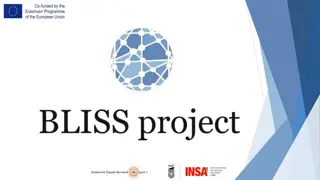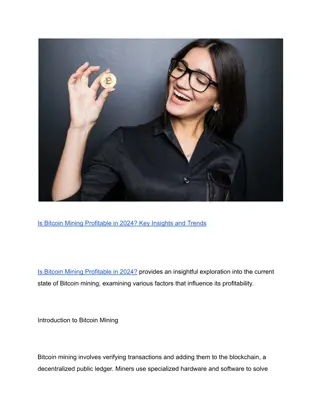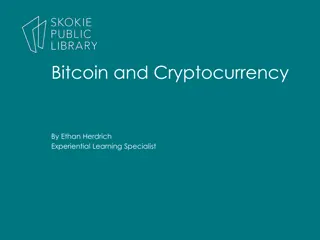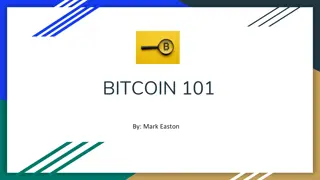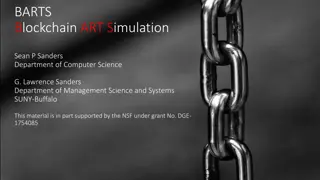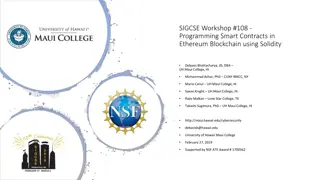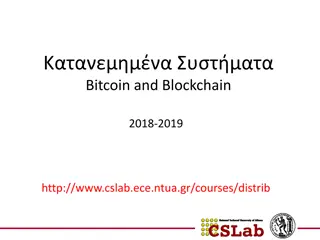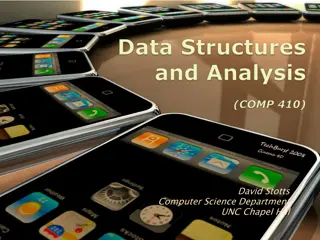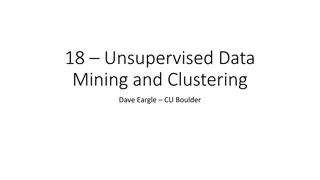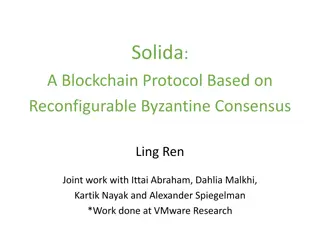Blockchain Technology: Bitcoin and Beyond
World of blockchain technology and its flagship cryptocurrency, Bitcoin. Discover the origins of Bitcoin, the construction and verification of blockchain, weaknesses and values associated with the technology, current and future applications, and more. Delve into the features of Bitcoin, its deflationary nature, divisibility, and resilience against counterfeiting, alongside its decentralized and consensus-driven system. Unearth the beginnings of Bitcoin, from its creation by Satoshi Nakamoto to the release of the first Genesis Block and subsequent milestones.
Download Presentation

Please find below an Image/Link to download the presentation.
The content on the website is provided AS IS for your information and personal use only. It may not be sold, licensed, or shared on other websites without obtaining consent from the author.If you encounter any issues during the download, it is possible that the publisher has removed the file from their server.
You are allowed to download the files provided on this website for personal or commercial use, subject to the condition that they are used lawfully. All files are the property of their respective owners.
The content on the website is provided AS IS for your information and personal use only. It may not be sold, licensed, or shared on other websites without obtaining consent from the author.
E N D
Presentation Transcript
Blockchain Technology Bitcoin and Beyond David V Duccini, MSc, MBA, CISSP, IFR Private Pilot, Rescue Diver aka The Little Duke http://linkedin.com/in/dvduccini 0
Agenda What is a Blockchain What is Bitcoin Where did Bitcoin come from? How does a Blockchain get built How does a Blockchain get verified Weaknesses of Blockchain technology Value Current applications of Blockchain technology Future applications of Blockchain technology Q & A 1
Blockchain Defined Simply defined a Blockchain is little more than a: Distributed Secure Logfile 2 A digital currency was in a lot of ways the first demonstrable use
What is Bitcoin A protocol that supports a decentralized, pseudo-anonymous, peer-to-peer digital currency* A publicly disclosed linked ledger of transactions stored in a blockchain A reward driven system for achieving consensus (mining) based on Proofs of Work for helping to secure the network A scare token economy with an eventual cap of about 21M bitcoins 3 * I would argue it behaves more like a security like a Stock or Bond than a currency, a crypto-equity
Bitcoin Whitepaper 2008.10.31* 4 * Halloween
Features of Bitcoin Essentially it s deflationary the reward is cut in half every four years, and tokens can be irrevocably destroyed Nearly infinitely divisible currency units supporting eight decimal places 0.00000001 (known as a Satoshi or Noncent*) Nominal transaction fee s paid to the network Same cost to send $.01 as $1,000,000 Consensus driven no central authority Counterfeit resilient Cannot add coins arbitrarily Cannot be double-spent Non-repudiation aka gone baby gone no recourse and no one to appeal to return sent tokens 5 http://www.urbandictionary.com/define.php?term=Noncents
When did it start? Satoshi Nakamoto created the reference implementation that began with a Genesis Block of 50 coins 2008 August 18 Domain name "bitcoin.org" registered[1]. October 31 Bitcoin design paper published November 09 Bitcoin project registered at SourceForge.net 2009 January 3 Genesis block established at 18:15:05 GMT January 9 Bitcoin v0.1 released and announced on the cryptography mailing list January 12 First Bitcoin transaction, in block 170 from Satoshi to Hal Finney 6 https://en.bitcoin.it/wiki/History
Why does it have value? The worth of a thing is the price it will bring. 7
Why does it matter? 3.6 Billion Dollar Market Cap! http://coinmarketcap.com 8
Decentralized The digital wallet operates in a peer to peer mode When it starts it bootstraps to find other wallets Originally it used the Internet Relay Chat (IRC) network Now based on DNS and seed nodes The wallet will synchronize with the network by downloading ALL of the transactions starting from the GENESIS block if necessary 338,540 blocks at time of slide prep Just over 20 GB Using a gossip protocol the wallets share all transaction information with their peers http://en.wikipedia.org/wiki/Gossip_protocol 9
Coins flow from Inputs to Outputs A coin owner transfers coins by digitally signing (via ECDSA) a hash digest of the previous transaction and the public key of the next owner. This signature is then appended to the end of the coin. 10
Pseudo Anonymous Using public key cryptography, specifically Elliptic Curve Cryptography due to its key strength and shorter keys Transactions are sent to public key addresses 1AjYPi8qryPCJu6xgdJuQzVnWFXLmxq9s3 1Give4dbry2pyJihnpqV6Urq2SGEhpz3K 11
Addresses are like Accounts The wallet listens for transactions addressed to any of its public keys and in theory is the only node that is able to decrypt and accept the transfer Coins are sent by broadcasting the transaction to the network which are verified to be viable and then added to a block Keys can represent a MULTI-SIG address that requires a N of M private keys in order to decrypt the message 12
Public Ledger Every viable transaction is stored in a public ledger Transactions are placed in blocks, which are linked by SHA256 hashes. https://blockchain.info 13
What is Bitcoin Video http://weusecoins.com 14
Arriving at Consensus Although the accepted chain can be considered a list, the block chain is best represented with a tree. The longest path represents the accepted chain. A participant choosing to extend an existing path in the block chain indicates a vote towards consensus on that path. The longer the path, the more computation was expended building it. 15
Consensus Process = Mining Originally the digital wallet could also participate in the consensus process by attempting to secure the network directly This process is known as mining Mining involves attempting to find a numerical value, known as a nonce that when combined with all open transactions can be hashed into a value that satisfies a certain difficulty Custom, purpose built-hardware has long since replaced the function such that its no longer productive for simple CPU based systems to compete in the mining process, and thus it was removed 16
Hashcash (Or How to Pay a Byzantine Generals Salary) Like many great ideas to become realized, it takes a confluence of other great ideas Based on the idea of HashCash, a Proof of Work concept invented by Adam Back in 1997 (http://www.hashcash.org/papers/hashcash.pdf) Originally proposed as an anti-spam throttling mechanism The core idea is that before accepting a transaction, the sender must first demonstrate a cost via a computationally hard problem that can simultaneously be easily verified. This generally referred to as a Proof of Work 17
The Role of Hashing A hash function is any function that can be used to map digital data of arbitrary size to digital data of fixed size, with slight differences in input data producing very big differences in output data. MD5, SHA1, SHA256 For example, the MD5 hashes of abc compared to abC abc 0bee89b07a248e27c83fc3d5951213c1 abC 2217c53a2f88ebadd9b3c1a79cde2638 The Quick Brown Fox Jumped Over the Lazy Dog 2dfd75162490ed3b4c893141f9ab37cf 18
Proof of Work A publicly auditable cost-function can be efficiently verified by any third party without access to any trapdoor or secret information. A fixed cost cost-function takes a fixed amount of resources to compute. The fastest algorithm to mint a fixed cost token is a deterministic algorithm. A probabilistic cost cost-function is one where the cost to the client of minting a token has a predictable expected time, but a random actual time as the client can most efficiently compute the cost-function by starting at a random start value. Sometimes the client will get lucky and start close to the solution. 19
The Hash Lottery Hashing is straightforward, but not challenging Unless the goal is to say, find me a hash value that satisfies a certain level of difficulty For example, let s say the challenge is find a hash-value that begins with a number of zeros, for a given input The Proof of Work comes from finding a number (known as a NONCE) that when added to the input changes the output of the hash value to satisfy the difficulty. In the Bitcoin world this is what mining is and in effect is little more than a lot of hash-power spent on guessing winning lottery numbers that satisfy the difficulty of the problem in order to obtain the reward from the network 20
The Payout The node that finds the best solution to the challenge is provisionally granted a reward Originally in Bitcoin it was 50 new coins Competing solutions are evaluated based on which node offers the higher number of transactions included in the candidate block as well as the level of over-satisfying the difficulty. For example, if two nodes offer a solution to the challenge and both have the same number of transactions, the reward will go to the node that found a NONCE that beat the challenge E.G. Find a hash that begins with 4 zeros The node that supplies a hash that has 5 zeros beats the node that only finds the minimum 21
Transaction Confirmation Having a transaction provisionally accepted into a candidate block signals that the network has verified that the inputs were viable Every new block accepted into the chain after the transaction was accepted is considered a confirmation Coins are not considered mature until there have been 6 confirmations (basically an hour assuming a 10 minute block cadence) New Coins created by the mining process are not valid until about 120 confirmations This is to assure that a node with more than 51% of the total hash-power does not pull off fraudulent transactions 22
What is Bitcoin Mining Video http://www.bitcoinmining.com 23
Why 51% Matters When does 1 + 1 = 3 ? * In the case of Bitcoin consensus goes to the chain with the highest number of blocks Not just in theory, but in practice several large mining pools have generated six blocks in a row To date the network has voluntarily shifted its mining power around or faced Distributed Denial of Service attacks 24 * When everyone says it does!
Purchase / Exchange Bitcoins In addition to mining bitcoins, they can be acquired from an exchange! 25
Merchants Accepting Bitcoin Overstock.com Newegg.com Microsoft XBOX Network Telsa Motors Time Inc (publisher) Virgin Galactic Wordpress BitPay claims 44,000 merchants! http://www.bitcoinvalues.net/who-accepts-bitcoins-payment-companies-stores-take- bitcoins.html 27
Other Uses of Blockchain Tek Registeries Authoritative Systems of Record Directory Services Timestamping Services ( Proof of Existence ) Counter-party Exchanges 28
Registries 29
Namecoin The first fork of Bitcoin with a purpose Securely record and transfer arbitrary names (keys). Attach a value (data) to the names (up to 520 bytes, more in the future). Transact namecoins, the digital currency ( , NMC). 30
Namecoin as a fault-tolerant Domain Name System Can act as a decentralized Domain Name Service that is resilient to censorship http://bit.namecoin.info 31
Alternates to Bitcoin aka Altcoins Good artists copy. Great artists steal. The first alternate blockchain was Namecoin Early attempts to re-level the playing field were made by changing the hashing function from SHA256 to SCRYPT SCRYPT is a memory intensive function that was thought to be resistant to customized hardware (false) Changes to the block emit time target were also changed from Bitcoins 10 minutes to 2.5 minutes to increase the velocity Newer ALTS incorporate every escalating hash functions, chained together in novel ways to resist giving purpose built hardware an advantage over CPU based mining 32
A Babel of Altcoins Now well over 500 alternate coins to Bitcoin 99.999% of them are simply brands / clones Most tinker with: the total coin supply the hashing functions (SHA256, SCRYPT, X11 et al) block emit time targets Proof of Something (Proof of Work, Proof of Stake) Notable Alts: Ripple, Litecoin, Dogecoin Total Market Cap: $ 4,540,315,390 (Bitcoin is 3.6B of that) http://coinmarketcap.com 33
Bitcoin 1.5 COUNTERPARTY.ORG Counterparty works by storing extra data in regular Bitcoin transactions, which makes every Counterparty transaction a Bitcoin transaction, albeit a very small one. MASTERCOIN.ORG The Master Protocol facilitates the creation and trading of smart properties and user currencies as well as other types of smart contracts. Mastercoins serve as the binding between bitcoins (BTC), smart properties and smart contracts created on top of the Mastercoin Protocol. NXT.ORG Asset creation and exchange on its own blockchain 34
Bitcoin 2.0 Smart Contracts Escrow-free exchange Insurance Voting Distributed Autonomous Organizations Identity & Reputation Systems http://bit.ly/idcoins Notable Implementations 35
Ethereum.org Turing complete contracts on a blockchain. Contracts are the main building blocks of Ethereum. A contract is a computer program that lives inside the distributed Ethereum network and has its own ether balance, memory and code. Every time you send a transaction to a contract, it executes its code, which can store data, send transactions and interact with other contracts. Contracts are maintained by the network, without any central ownership or control. Contracts are written in languages instantly familiar to any programmer and powered by Ether, Ethereum's cryptofuel. 36
Bad Uses for Good Technology Guns Don t Kill People. People Kill People Bitcoin has had its fair share of bad press Silk Road An online anonymous marketplace for censorship-free commerce Ross Ulbricht s trial starts this week Bitinstant Charlie Shrem plead guilty to aiding money laundering MT-GOX aka Magic The Gathering Online eXchange 700,000 coins missing Neo & Bee Bitstamp 37
Resources Bitcoin: A Peer-to-Peer Electronic Cash System https://bitcoin.org/bitcoin.pdf http://coinmarketcap.com Hashcash.org IDCoins: A Web of Trust Blockchain for Identity and Reputation, David V Duccini, http://bit.ly/idcoins Mastering Bitcoin , Andreas M.Antonopoulos , O Reilly Media http://www.bitcoinsecurity.org/2012/07/22/what-is-bitcoin/ https://www.weusecoins.com 38
Q&A 39
